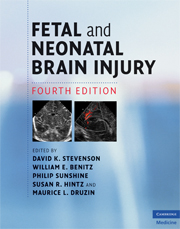Book contents
- Frontmatter
- Contents
- List of contributors
- Foreword
- Preface
- Section 1 Epidemiology, pathophysiology, and pathogenesis of fetal and neonatal brain injury
- 1 Neonatal encephalopathy: epidemiology and overview
- 2 Mechanisms of neurodegeneration and therapeutics in animal models of neonatal hypoxic–ischemic encephalopathy
- 3 Cellular and molecular biology of hypoxic–ischemic encephalopathy
- 4 The pathogenesis of preterm brain injury
- Section 2 Pregnancy, labor, and delivery complications causing brain injury
- Section 3 Diagnosis of the infant with brain injury
- Section 4 Specific conditions associated with fetal and neonatal brain injury
- Section 5 Management of the depressed or neurologically dysfunctional neonate
- Section 6 Assessing outcome of the brain-injured infant
- Index
- Plate section
- References
2 - Mechanisms of neurodegeneration and therapeutics in animal models of neonatal hypoxic–ischemic encephalopathy
from Section 1 - Epidemiology, pathophysiology, and pathogenesis of fetal and neonatal brain injury
Published online by Cambridge University Press: 12 January 2010
- Frontmatter
- Contents
- List of contributors
- Foreword
- Preface
- Section 1 Epidemiology, pathophysiology, and pathogenesis of fetal and neonatal brain injury
- 1 Neonatal encephalopathy: epidemiology and overview
- 2 Mechanisms of neurodegeneration and therapeutics in animal models of neonatal hypoxic–ischemic encephalopathy
- 3 Cellular and molecular biology of hypoxic–ischemic encephalopathy
- 4 The pathogenesis of preterm brain injury
- Section 2 Pregnancy, labor, and delivery complications causing brain injury
- Section 3 Diagnosis of the infant with brain injury
- Section 4 Specific conditions associated with fetal and neonatal brain injury
- Section 5 Management of the depressed or neurologically dysfunctional neonate
- Section 6 Assessing outcome of the brain-injured infant
- Index
- Plate section
- References
Summary
Introduction
Perinatal hypoxia–ischemia (HI) and asphyxia due to umbilical cord prolapse, delivery complications, airway obstruction, asthma, drowning, and cardiac arrest are significant causes of brain damage, mortality, and morbidity in infants and young children. The incidence of HI encephalopathy (HIE), for example, is ∼ 2 to 4/1000 live term births. Term infants that experience episodes of asphyxia can have damage in the brainstem and forebrain, with the basal ganglia, particularly the striatum, and somatosensory systems showing selective vulnerability. Infants surviving with HIE can have long-term neurological disability, including disorders in movement, visual deficits, learning and cognition impairments, and epilepsy. Many of these neurological disabilities are contributors to the complex clinical syndrome of cerebral palsy. Neuroimaging studies of full-term neonates and experimental studies on animal models suggest that this pattern of selective vulnerability is related to local metabolism and brain regional interconnections that instigate and propagate the damage within specific neural systems. This idea has been called the “metabolism-connectivity concept”. The neurodegeneration is partly triggered by excitotoxic mechanisms resulting from excessive activation of excitatory glutamate receptors and oxidative stress. The ion channel N-methyl-d-aspartate (NMDA) receptor and intracellular signaling networks involving calcium, nitric oxide synthase (NOS), mitochondria, and reactive oxygen species (ROS), such as superoxide, nitric oxide (NO), peroxynitrite, and hydrogen peroxide (H2O2), appear to have instrumental roles in the neuronal cell death leading to perinatal HIE.
- Type
- Chapter
- Information
- Fetal and Neonatal Brain Injury , pp. 14 - 37Publisher: Cambridge University PressPrint publication year: 2009



